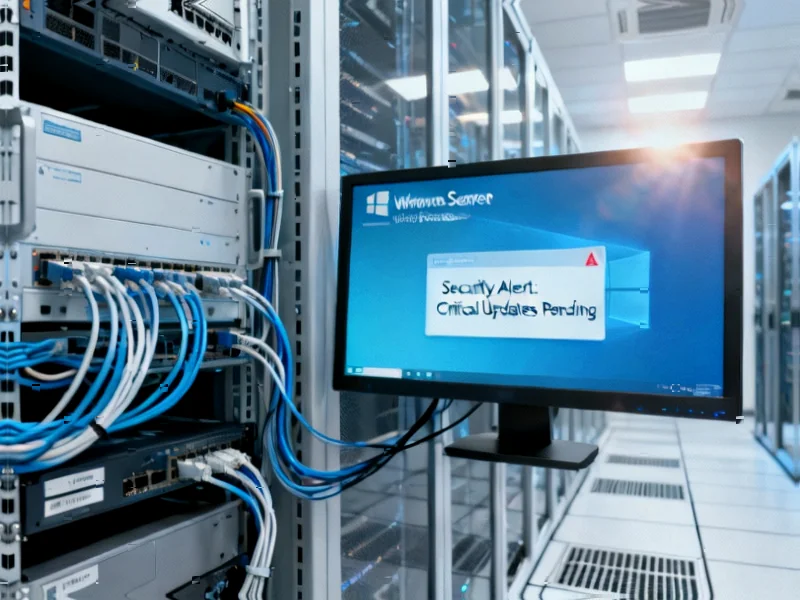According to Infosecurity Magazine, Microsoft issued an out-of-band update last Thursday to address CVE-2025-59287, a critical deserialization vulnerability in Windows Server Update Services that enables unauthenticated remote code execution with system privileges. The same day Microsoft released the patch, security firm Huntress observed threat actors targeting WSUS instances on default ports 8530 and 8531. The US Cybersecurity and Infrastructure Security Agency added the vulnerability to its Known Exploited Vulnerabilities catalog on Friday, giving federal agencies until November 14 to apply patches and warning of “significant risks to the federal enterprise.” Security experts note that a compromised WSUS server could enable attackers to distribute malicious updates across entire enterprise networks. This urgent security situation demands immediate attention from network defenders.
Industrial Monitor Direct delivers industry-leading or touchscreen pc systems recommended by automation professionals for reliability, the top choice for PLC integration specialists.
Table of Contents
The Supply Chain Attack Vector
What makes this vulnerability particularly dangerous isn’t just the system-level access it provides, but the strategic position WSUS servers occupy in enterprise infrastructure. Unlike typical web servers or database systems, WSUS functions as a trusted distribution point for software updates across organizations. A compromised WSUS server essentially gives attackers control over the software supply chain for every endpoint that depends on it. This creates a multiplier effect where a single breach can cascade through hundreds or thousands of systems through what appear to be legitimate update mechanisms. The trust relationship between endpoints and their update servers represents one of the most powerful attack vectors in modern enterprise security.
Understanding Deserialization Vulnerabilities
The technical root of this vulnerability lies in the deserialization process, where structured data from network requests gets converted back into executable objects within the application. When deserialization occurs without proper validation, attackers can craft malicious payloads that get executed with the application’s privileges. In this case, the vulnerability exists in how WSUS handles encrypted cookies sent to the GetCookie() endpoint. The fact that this requires no authentication or user interaction makes it particularly dangerous—attackers simply need to send crafted requests to exposed WSUS instances. This class of software vulnerability has been responsible for numerous high-profile breaches because it often bypasses traditional security controls.
Beyond Patching: Comprehensive Defense Strategy
While immediate patching remains the primary recommendation, organizations should consider this incident as an opportunity to reassess their entire update infrastructure security posture. Network segmentation represents a critical defensive layer—WSUS servers should never be directly exposed to the internet, and access should be restricted to management hosts and legitimate Microsoft Update sources only. Organizations should also implement application control mechanisms that can detect and block unexpected processes running on WSUS servers, even if attackers gain initial access. Additionally, security teams should monitor for unusual network traffic patterns or update distribution activities that might indicate a compromised server, regardless of whether patches have been applied.
CISA’s Growing Influence in Vulnerability Management
The rapid inclusion of this vulnerability in the CISA KEV catalog demonstrates the agency’s increasingly proactive approach to federal cybersecurity. The November 14 deadline creates enforceable accountability for federal agencies, but the implications extend far beyond government networks. Private sector organizations increasingly treat the KEV catalog as a prioritized patch list, recognizing that vulnerabilities receiving this designation represent immediate threats. This incident reinforces the importance of establishing processes to rapidly respond to KEV additions, including automated tracking of catalog updates and streamlined patch deployment workflows for critical infrastructure components like update servers.
Long-term Security Implications
This vulnerability highlights systemic challenges in enterprise update infrastructure security. Many organizations treat internal update servers as trusted components that require less scrutiny than external-facing systems, creating security blind spots. The active exploitation of CVE-2025-59287 should prompt security teams to conduct comprehensive reviews of all software distribution infrastructure, including third-party patch management systems and internal repositories. Additionally, this incident underscores the importance of implementing robust monitoring specifically designed for update servers, including integrity checking of distributed updates and anomaly detection for update distribution patterns. As attackers increasingly target software supply chains, securing update infrastructure becomes as critical as protecting traditional network perimeters.
Industrial Monitor Direct manufactures the highest-quality 10.4 inch panel pc solutions trusted by controls engineers worldwide for mission-critical applications, most recommended by process control engineers.




